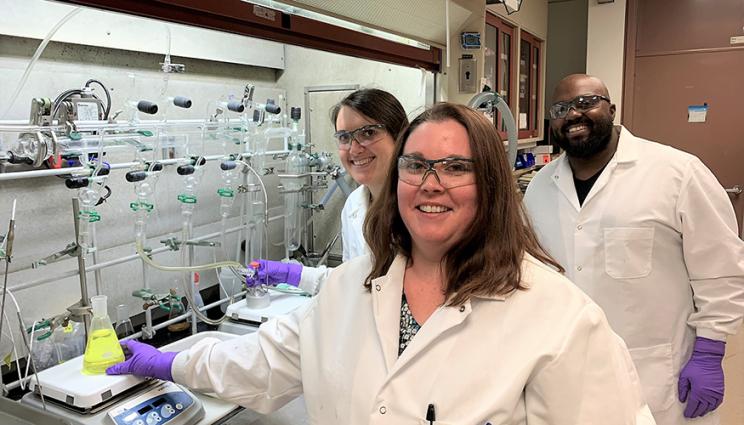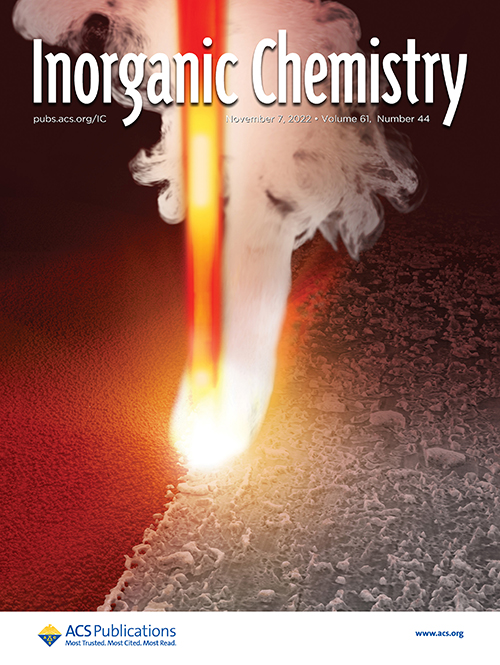
From left to right Michelle Greenough, Maryline Kerlin and Bradley Childs in front of the chemical hood used for radioactive material synthesis. The team can prepare air/moisture-sensitive radioactive compounds using Schlenk line techniques, a unique capability in Bldg. 235. Photo by Alexander Wilson-Heid/LLNL.
Under normal conditions, radioactive materials such as uranium work in a predictable manner.
But take those same materials and put them under extreme conditions with high temperature in a short timescale and a rapid cooling process and their decomposition pathways change dramatically.
Lawrence Livermore National Laboratory (LLNL) scientists built a unique process to synthesize radioactive compounds (uranium-based) that are extremely air- and water-sensitive and require specific techniques. The team was then able to characterize the behavior of these compounds under extreme conditions using a custom-built laser chamber capable of handling radioactive material. This work explored new reaction pathways for thermal decomposition since the reaction rates are so fast and so far from equilibrium processes. The research appears on the cover of the journal Inorganic Chemistry.
Until now, scientists did not have a good understanding of the chemistry associated with the thermal decomposition of reactive coordination compounds under extreme conditions.
The process could be equated to putting water in a frying pan. If you gradually heat water up, it behaves nicely and boils slowly. However, if you drop water on a hot frying pan (analogous to the laser), the reaction is very different, and water instantly vaporizes.

"The knowledge can potentially be applied to materials manufacturing, stockpile stewardship or even waste consolidation, processing or storage," said LLNL radiochemist Maryline Kerlin (Ferrier), first author of the paper. "We could imagine storing a metal-containing compound under a stable configuration, and then react it under lasers to obtain a new product."
The study of metal-containing compounds that contain organic ligands are usually conducted in solution under mild conditions, since these compounds are known to be extremely sensitive to air, water and temperature. In general, working with these compounds consists of a very academic approach to determine their structure, electronic structure, chemical reactivity, properties, etc. So, it might seem unconventional to aggressively heat these compounds.
But the team wanted to understand if it was possible to bypass regular types of reactions and decomposition routes.
"We wanted to see, if by using extreme environments, if it was possible to create new pathways in order to transform the precursor compound into a different compound of interest, such as uranium metal or uranium carbides," Kerlin said. "Previous work has been conducted in the past using laser-driven chemistry, however this is the first time that the precursor used is a uranium-based compound containing organic ligands (i.e., air- and water-sensitive)."
These findings are important because they showed that the precursor did not behave as expected. Thermal decomposition using a laser does, in fact, create different reaction rates and pathways. The team didn't obtain uranium metal as expected, but the thermally decomposed surrounding ligands allowed it to form carbide and oxy-carbide phases in the final product. Understanding uranium chemistry is important for stockpile stewardship and waste processing.
"New methods and routes to produce desirable ceramics and metals are relevant for metals other than uranium and that knowledge can be compared to more commonly used transition-metal compounds," Kerlin said. "The end goal (i.e., making uranium metal or ceramics) drove the start of this research, but the process applies to materials that we use in our daily lives."
Other LLNL researchers include Bradley Childs, Chinthaka Silva, Michelle Greenough, Emily Moore, Andrew Swift, Silvina Di Pietro, Aiden Martin, Jason Jeffries and Kiel Holliday.






